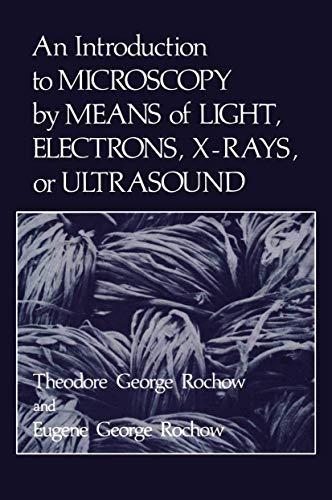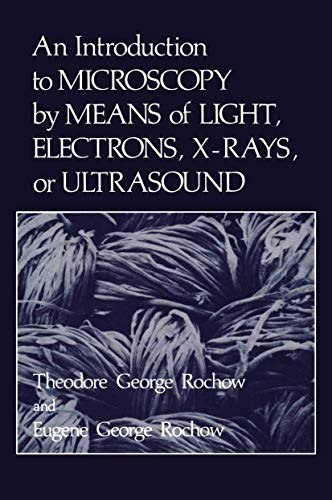introduction microscopy means light de rochow eugene (18 résultats)
Filtres de recherche
Type d'article
- Tous les types de produits
- Livres (18)
- Magazines & Périodiques (Aucun autre résultat ne correspond à ces critères)
- Bandes dessinées (Aucun autre résultat ne correspond à ces critères)
- Partitions de musique (Aucun autre résultat ne correspond à ces critères)
- Art, Affiches et Gravures (Aucun autre résultat ne correspond à ces critères)
- Photographies (Aucun autre résultat ne correspond à ces critères)
- Cartes (Aucun autre résultat ne correspond à ces critères)
- Manuscrits & Papiers anciens (Aucun autre résultat ne correspond à ces critères)
Etat En savoir plus
Particularités
- Ed. originale (Aucun autre résultat ne correspond à ces critères)
- Signé (Aucun autre résultat ne correspond à ces critères)
- Jaquette (1)
- Avec images (5)
- Sans impressions à la demande (13)
Langue (2)
Livraison gratuite
Pays
Evaluation du vendeur
-
An Introduction to Microscopy by Means of Light, Electrons, X-Rays, or Ultrasound
Vendeur : Better World Books, Mishawaka, IN, Etats-Unis
EUR 13,56
Gratuit expédition vers Etats-UnisQuantité disponible : 2 disponible(s)
Ajouter au panierEtat : Good. Former library book; may include library markings. Used book that is in clean, average condition without any missing pages.
-
An Introduction to Microscopy by Means of Light, Electrons, X-Rays, or Ultrasound
Vendeur : Better World Books Ltd, Dunfermline, Royaume-Uni
EUR 5,40
EUR 9,08 expédition depuis Royaume-Uni vers Etats-UnisQuantité disponible : 1 disponible(s)
Ajouter au panierEtat : Good. Ships from the UK. Former library book; may include library markings. Used book that is in clean, average condition without any missing pages.
-
An Introduction to Microscopy by Means of Light, Electrons, X-Rays, or Ultrasound
Vendeur : Phatpocket Limited, Waltham Abbey, HERTS, Royaume-Uni
EUR 4,10
EUR 12,08 expédition depuis Royaume-Uni vers Etats-UnisQuantité disponible : 1 disponible(s)
Ajouter au panierEtat : Good. Your purchase helps support Sri Lankan Children's Charity 'The Rainbow Centre'. Ex-library, so some stamps and wear, but in good overall condition. Our donations to The Rainbow Centre have helped provide an education and a safe haven to hundreds of children who live in appalling conditions.
-
An Introduction to Microscopy by Means of Light, Electrons, X-Rays, or Ultrasound
Vendeur : Phatpocket Limited, Waltham Abbey, HERTS, Royaume-Uni
EUR 4,10
EUR 12,08 expédition depuis Royaume-Uni vers Etats-UnisQuantité disponible : 1 disponible(s)
Ajouter au panierEtat : Acceptable. Used - Acceptable. Your purchase helps support Sri Lankan Children's Charity 'The Rainbow Centre'. Ex-library with wear and barcode page may have been removed. Our donations to The Rainbow Centre have helped provide an education and a safe haven to hundreds of children who live in appalling conditions.
-
An Introduction to Microscopy by Means of Light, Electrons, X-Rays orUltrasound
Edité par Plenum (1978) New York, 1978
Vendeur : Prairie Archives, Springfield, IL, Etats-Unis
Membre d'association : MWABA
EUR 8,89
EUR 4,23 expédition vers Etats-UnisQuantité disponible : 1 disponible(s)
Ajouter au panierGood plus or better, light general wear hardbound Lightly worn, edgetorn jacket.
-
An Introduction to Microscopy by Means of Light, Electrons, X-Rays, or Ultrasound
Vendeur : Lucky's Textbooks, Dallas, TX, Etats-Unis
EUR 103,56
EUR 3,45 expédition vers Etats-UnisQuantité disponible : Plus de 20 disponibles
Ajouter au panierEtat : New.
-
An Introduction to Microscopy by Means of Light, Electrons, X-Rays, or Ultrasound
Vendeur : Ria Christie Collections, Uxbridge, Royaume-Uni
EUR 110,06
EUR 13,60 expédition depuis Royaume-Uni vers Etats-UnisQuantité disponible : Plus de 20 disponibles
Ajouter au panierEtat : New. In.
-
An Introduction to Microscopy by Means of Light, Electrons, X-Rays, or Ultrasound
Vendeur : moluna, Greven, Allemagne
EUR 92,27
EUR 48,99 expédition depuis Allemagne vers Etats-UnisQuantité disponible : Plus de 20 disponibles
Ajouter au panierEtat : New.
-
An Introduction to Microscopy by Means of Light, Electrons, X-Rays, or Ultrasound
Vendeur : Books Puddle, New York, NY, Etats-Unis
EUR 142,88
EUR 3,45 expédition vers Etats-UnisQuantité disponible : 4 disponible(s)
Ajouter au panierEtat : New. pp. 388.
-
An Introduction to Microscopy by Means of Light, Electrons, X-Rays, or Ultrasound
Vendeur : Revaluation Books, Exeter, Royaume-Uni
EUR 153,97
EUR 14,19 expédition depuis Royaume-Uni vers Etats-UnisQuantité disponible : 2 disponible(s)
Ajouter au panierPaperback. Etat : Brand New. reprint edition. 367 pages. 9.00x6.00x1.00 inches. In Stock.
-
An Introduction to Microscopy by Means of Light, Electrons, X-Rays, or Ultrasound
Vendeur : preigu, Osnabrück, Allemagne
EUR 95,80
EUR 70 expédition depuis Allemagne vers Etats-UnisQuantité disponible : 5 disponible(s)
Ajouter au panierTaschenbuch. Etat : Neu. An Introduction to Microscopy by Means of Light, Electrons, X-Rays, or Ultrasound | Eugene Rochow | Taschenbuch | xvi | Englisch | 2012 | Humana | EAN 9781468424560 | Verantwortliche Person für die EU: Springer Verlag GmbH, Tiergartenstr. 17, 69121 Heidelberg, juergen[dot]hartmann[at]springer[dot]com | Anbieter: preigu.
-
An Introduction to Microscopy by Means of Light, Electrons, X-Rays, or Ultrasound
Vendeur : AHA-BUCH GmbH, Einbeck, Allemagne
EUR 114,36
EUR 62,81 expédition depuis Allemagne vers Etats-UnisQuantité disponible : 1 disponible(s)
Ajouter au panierTaschenbuch. Etat : Neu. Druck auf Anfrage Neuware - Printed after ordering - Many people look upon a microscope as a mere instrument(l); to them microscopy is instrumentation. Other people consider a microscope to be simply an aid to the eye; to them microscopy is primarily an expan sion of macroscopy. In actuality, microscopy is both objective and sub jective; it is seeing through an instrument by means of the eye, and more importantly, the brain. The function of the brain is to interpret the eye's image in terms of the object's structure. Thought and experience are required to distinguish structure from artifact. It is said that Galileo (1564-1642) had his associates first look through his telescope microscope at very familiar objects to convince them that the image was a true representation of the object. Then he would have them proceed to hitherto unknown worlds too far or too small to be seen with the un aided eye. Since Galileo's time, light microscopes have been improved so much that performance is now very close to theoretical limits. Electron microscopes have been developed in the last four decades to exhibit thousands of times the resolving power of the light microscope. Through the news media everyone is made aware of the marvelous microscopical accomplishments in imagery. However, little or no hint is given as to what parts of the image are derived from the specimen itself and what parts are from the instrumentation, to say nothing of the changes made during preparation of the specimen.
-
An Introduction to Microscopy by Means of Light, Electrons, X-Rays, or Ultrasound
Vendeur : Mispah books, Redhill, SURRE, Royaume-Uni
EUR 181,24
EUR 28,38 expédition depuis Royaume-Uni vers Etats-UnisQuantité disponible : 1 disponible(s)
Ajouter au panierPaperback. Etat : Like New. Like New. book.
-
An Introduction to Microscopy by Means of Light, Electrons, X-Rays, or Ultrasound
Edité par Springer US, Springer New York Dez 2012, 2012
ISBN 10 : 1468424564 ISBN 13 : 9781468424560
Langue: anglais
Vendeur : BuchWeltWeit Ludwig Meier e.K., Bergisch Gladbach, Allemagne
EUR 106,99
EUR 23 expédition depuis Allemagne vers Etats-UnisQuantité disponible : 2 disponible(s)
Ajouter au panierTaschenbuch. Etat : Neu. This item is printed on demand - it takes 3-4 days longer - Neuware -Many people look upon a microscope as a mere instrument(l); to them microscopy is instrumentation. Other people consider a microscope to be simply an aid to the eye; to them microscopy is primarily an expan sion of macroscopy. In actuality, microscopy is both objective and sub jective; it is seeing through an instrument by means of the eye, and more importantly, the brain. The function of the brain is to interpret the eye's image in terms of the object's structure. Thought and experience are required to distinguish structure from artifact. It is said that Galileo (1564-1642) had his associates first look through his telescope microscope at very familiar objects to convince them that the image was a true representation of the object. Then he would have them proceed to hitherto unknown worlds too far or too small to be seen with the un aided eye. Since Galileo's time, light microscopes have been improved so much that performance is now very close to theoretical limits. Electron microscopes have been developed in the last four decades to exhibit thousands of times the resolving power of the light microscope. Through the news media everyone is made aware of the marvelous microscopical accomplishments in imagery. However, little or no hint is given as to what parts of the image are derived from the specimen itself and what parts are from the instrumentation, to say nothing of the changes made during preparation of the specimen. 388 pp. Englisch.
-
An Introduction to Microscopy by Means of Light, Electrons, X-Rays, or Ultrasound
Edité par Springer-Verlag New York Inc., 2012
ISBN 10 : 1468424564 ISBN 13 : 9781468424560
Langue: anglais
Vendeur : THE SAINT BOOKSTORE, Southport, Royaume-Uni
EUR 134,08
EUR 18,64 expédition depuis Royaume-Uni vers Etats-UnisQuantité disponible : Plus de 20 disponibles
Ajouter au panierPaperback / softback. Etat : New. This item is printed on demand. New copy - Usually dispatched within 5-9 working days 567.
-
An Introduction to Microscopy by Means of Light, Electrons, X-Rays, or Ultrasound
Vendeur : Majestic Books, Hounslow, Royaume-Uni
EUR 152,42
EUR 7,38 expédition depuis Royaume-Uni vers Etats-UnisQuantité disponible : 4 disponible(s)
Ajouter au panierEtat : New. Print on Demand pp. 388.
-
An Introduction to Microscopy by Means of Light, Electrons, X-Rays, or Ultrasound
Vendeur : Biblios, Frankfurt am main, HESSE, Allemagne
EUR 153,10
EUR 9,95 expédition depuis Allemagne vers Etats-UnisQuantité disponible : 4 disponible(s)
Ajouter au panierEtat : New. PRINT ON DEMAND pp. 388.
-
An Introduction to Microscopy by Means of Light, Electrons, X-Rays, or Ultrasound
Edité par Springer US, Springer New York Dez 2012, 2012
ISBN 10 : 1468424564 ISBN 13 : 9781468424560
Langue: anglais
Vendeur : buchversandmimpf2000, Emtmannsberg, BAYE, Allemagne
EUR 106,99
EUR 60 expédition depuis Allemagne vers Etats-UnisQuantité disponible : 1 disponible(s)
Ajouter au panierTaschenbuch. Etat : Neu. This item is printed on demand - Print on Demand Titel. Neuware -Many people look upon a microscope as a mere instrument(l); to them microscopy is instrumentation. Other people consider a microscope to be simply an aid to the eye; to them microscopy is primarily an expan sion of macroscopy. In actuality, microscopy is both objective and sub jective; it is seeing through an instrument by means of the eye, and more importantly, the brain. The function of the brain is to interpret the eye's image in terms of the object's structure. Thought and experience are required to distinguish structure from artifact. It is said that Galileo (1564-1642) had his associates first look through his telescope microscope at very familiar objects to convince them that the image was a true representation of the object. Then he would have them proceed to hitherto unknown worlds too far or too small to be seen with the un aided eye. Since Galileo's time, light microscopes have been improved so much that performance is now very close to theoretical limits. Electron microscopes have been developed in the last four decades to exhibit thousands of times the resolving power of the light microscope. Through the news media everyone is made aware of the marvelous microscopical accomplishments in imagery. However, little or no hint is given as to what parts of the image are derived from the specimen itself and what parts are from the instrumentation, to say nothing of the changes made during preparation of the specimen.Springer Verlag GmbH, Tiergartenstr. 17, 69121 Heidelberg 388 pp. Englisch.









